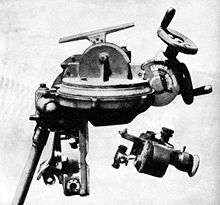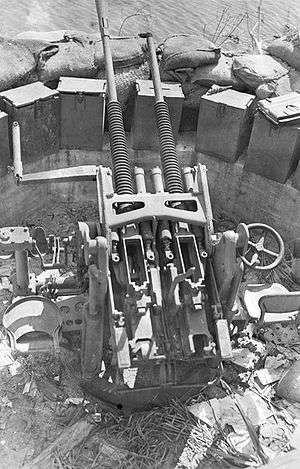Type 96 25 mm AT/AA Gun
| Type 96 25 mm dual purpose gun | |
|---|---|
|
A US military photograph of a captured dual gun emplacement on Guam in 1944. | |
| Type | Anti-Aircraft/Anti-tank, Autocannon |
| Place of origin |
|
| Service history | |
| In service | 1936–1945 |
| Used by |
|
| Wars | World War II |
| Production history | |
| Designer | Hotchkiss |
| Designed | 1935 |
| Number built | 33,000 |
| Specifications | |
| Weight |
Single Barrel: 785 kg (1,731 lb) Twin Barrel: 1,100 kg (2,400 lb) Triple Barrel: 1,800 kg (4,000 lb) |
| Barrel length | 1.5 m (4 ft 11 in) L/60 |
| Crew | 9, 7 or 3 depending on number of barrels |
|
| |
| Shell | 25×163 mm |
| Caliber | 25 mm (0.98 in) |
| Action | gas operated |
| Elevation | -10° to +85° |
| Traverse | 360° |
| Rate of fire |
200–260 rpm (cyclic) 110 rpm (effective) |
| Muzzle velocity | 820 m/s (2,700 ft/s)[1] |
| Effective firing range | 6,800 m (7,439 yards) at 45° with HE shell[2] |
| Feed system | 15-round box magazine |
The Type 96 25mm Gun (九六式二十五粍高角機銃 Kyūroku-shiki nijyūgo-miri Kōkakukijū) was an automatic cannon used by the Imperial Japanese Navy during World War II. A local built variant of the French Hotchkiss 25mm anti-aircraft gun, it was primarily used as an anti-aircraft gun in fixed mounts with between one and three guns, but was designed as a dual-purpose weapon for use against armored vehicles as well.
History and development
In 1935 the Imperial Japanese Navy decided to replace the earlier 40 mm Vickers "pom-pom" guns with a 25 mm Hotchkiss design. A party of Japanese officers and engineers traveled to France to evaluate the design in 1935 and an order was placed for a number of guns and mounts for evaluation. Firing tests of these guns were conducted at Yokosuka Naval Arsenal in 1935. The first few weapons were built in France under the designation “Type 94” and “Type 95”, with the mass production model produced at the Yokosuka Arsenal being designated “Type 96”.
The Japanese made a number of minor changes to the original Hotchkiss design and production process, changing some components from forgings to castings to simplify production and replacing the simple conical flash suppressor with a Rheinmetall-type design. A submarine-mountable version of the gun was also produced, which made extensive use of stainless steel.
The double mount type was the first to enter service, with triple mounts following in 1941 and finally single mounts later in 1943.
Design
The Type 96 25mm Gun is a simple air-cooled gas operated design. The barrel is a forging screwed into the breech mechanism. Additional support is provided to the breech end of the gun barrel by the finned cooling jacket. The barrel is changeable, but the operation required two men and special tools to complete, and took a trained crew approximately five minutes.[3] By adjusting the gas valve setting it was possible to vary the rate of fire between 200 and 260 rounds per minute, with 220 rounds per minute being the standard setting.
The gun mounts were normally provided with one of three gun sights:
- A Le Prieur mechanical lead computing sight
- An open ring sight
- An etched glass optical ring sight

Land mountings and all single mountings all used the single open ring sight. The Type 95 sight was used on ship-based multiple mounts, in the case where the mount has a powered drive linked to a fire director it was used as a backup.
The Type 95 sight was originally designed with a maximum target speed of 600 kilometers per hour; however, experience showed that aircraft often exceeded this speed. To compensate for the problem a ring was added to the sighting telescope to provide an additional offset for the speeds up to 900 kilometers per hour.
The gun was normally used without a gun shield, although some multiple mounts on Yamato-class battleships were fitted with Ducol (High tensile steel) shields. Many ship based mounts also had splinter shields.
Effectiveness

In interviews conducted by the U.S. Naval Technical Mission to Japan after the end of the war, Japanese military personnel cited it as the most reliable Japanese anti-aircraft weapon, but second in effectiveness to the Type 98 100 mm anti-aircraft gun.[3] The Type 96 was most effective when used at ranges of 1,000 meters or less. Japanese military estimated that it required an average of 1,500 rounds to down an aircraft at a height of 1,000 meters and a range of 2,000 meters and that fire beyond that range was completely ineffective. Later in the war when ammunition supply was restricted, firing was held until the targets were within 800 meters range this dropped to a low as seven rounds per aircraft according to Japanese sources.[4] The Type 96 was a mediocre weapon, hampered by slow training and elevating speeds (even in power-operated triple mounts), excessive vibration and muzzle flash, and the fact that the ammunition feed was via a 15-round fixed magazine which necessitated ceasing fire every time the magazine had to be changed.[5] According to "US Naval Technical Mission to Japan report O-47(N)-2", all magazines had to be loaded by hand as no specialized loading equipment was ever developed. Overall, it was more comparable to the 20mm Oerlikon, though vastly inferior to the 40mm Bofors weapons used by the US in every respect except rate of fire (and only barely in that respect: the Bofors could put out a sustained 120 round/minute because of its constant-fire top-fed ammo clip design; whereas the 25mm's frequent ammo box changes lowered its nominal rate of fire to only half of its theoretical maximum of 260 rounds / minute). [6]
The Japanese ranked in order of seriousness the problems with the gun as:
- Elevation and traverse was too slow, even with powered mounts
- The sights were ineffective against high speed targets
- Firing the multiple mounts caused excessive vibration which reduced accuracy and prevented effective target tracking
- Too little ammunition in each magazine resulted in a low overall rate of fire (the gun used 15 round self-contained magazines).
In Rapid Fire, Anthony Williams writes that the intermediate calibre weapons (including the US Navy's 1.1"/75 caliber gun" 28x199mm L/75) were relatively unsuccessful during World War II, the mounts were much heavier and more complex, but the shells lacked the range and hitting power of the larger 37 and 40 millimeter mounts.[7] Certainly the Japanese ranked increasing the caliber of autocannons as the number one priority of research and development[3]
Variants
- Type 94 - French built
- Type 95 - French built
- Type 96 - Built in Japan
- Type 96 Model 1 - Used on land and in warships in single, double and triple mountings. The single mount was free swinging, while double and triple mounts had hand-wheel traverse.
- Type 96 Model 2 - Used on warships in double and triple mountings.
- Type 96 Model 3 - Used on warships in single free-swinging mounts.
- Type 96 Model 4 - Used on submarines, in single, double and triple mounts. Single mounts can be manually lowered into the submarine.
- Type 96 Model 4 mod 1 - Used on submarines in free-swinging single mounts. Could not be lowered into the submarine.
- Type 96 Model 4 mod 2 - Used on submarines in free-swinging single mounts. Could be remotely lowered into the submarine.
- Type 96 Model 5 - Used on submarines in twin and triple geared mounts.
- Type 96 Model 6 - Used on land on single gun twin wheel carriages.
- Type 96 Model 8 - Used on land on single gun twin wheel carriages.
- Type 96 Model 10 - Used on torpedo boats on a ring mounting with geared elevation in single gun mounts.
Ammunition

The Type 96 cartridge case was a rimless type design with a deep extraction groove at the base. The projectiles fired by the weapon were slightly unusual in that they had two rotating bands. The forward band was slightly smaller in diameter than the rear band. It was believed that this was to reduce wear on the rifling near the chamber. The case of the cartridge was crimped around the rear rotating band. The complete round weighed approximately 820 g (1.81 lb) with the projectile weighing 320 g (0.71 lb).[1]
The propellant was 102 grams of single-perforated, graphited grains of nitrocellulose approximately 2 millimeters in diameter and between 2.5 and 4.5 millimeters in length.[8]
Normally one tracer round was added every four or five rounds to aid laying.[9]
- high-explosive shells. Orange body.
- High explosive incendiary. Green body.
- High explosive tracer. Orange or red body.
- High explosive tracer self-destroying. Orange or red body.
- armor-piercing. Black, white or smoky blue body.
Combat record
The Type 96 was the standard Japanese medium antiaircraft weapon of the Imperial Japanese Navy, being mounted aboard practically everything that floated, and was also used in land bases in the Japanese Empire and in the Japanese overseas combat fronts. These weapons were also used as anti-tank guns in some defensive actions in Pacific theaters and against land objectives in southeast Asia/Chinese mainland during the Pacific War, however against tanks such as the M4 Sherman its light shell was incapable of penetrating its armor at any range.
Notes
- 1 2 Johnson, Melvin M., Jr. (1944). Rifles and Machine Guns. William Morrow and Company. p. 385.
- ↑ Japanese Cruisers of the Pacific War
- 1 2 3 Japanese Naval Guns and Mounts, Article 2, AA Machine guns and Mounts O-47(N)-2. U.S. Naval Technical Mission To Japan. 1946.
- ↑ Effectiveness of Japanese AA fire O-44. U.S. Naval Technical Mission To Japan. 1946.
- ↑ "Japan 25 mm/60 (1") Type 96 Model 1". Retrieved 14 Dec 2013.
- ↑ "Japanese Naval Ordnance, 25mm/60 caliber AA". Retrieved 14 May 2013.
- ↑ Anthony G. Williams. Rapid Fire.
- ↑ Japanese Explosive Ordnance. Departments of the Army and Navy. 1953.
- ↑ Kojinsha No.6, Warships of the Imperial Japanese Navy.
References
- Bishop, Chris (eds) The Encyclopedia of Weapons of World War II. Barnes & Nobel. 1998. ISBN 0-7607-1022-8.
- Chant, Chris. Artillery of World War II, Zenith Press, 2001, ISBN 0-7603-1172-2.
- McLean, Donald B. Japanese Artillery; Weapons and Tactics. Wickenburg, Ariz.: Normount Technical Publications 1973. ISBN 0-87947-157-3.
External links
| Wikimedia Commons has media related to Type96 25mm AA Gun. |
- Navweaps.com
- Combinedfleet.com
- "Antiaircraft Artillery", TM-E 30-480: Handbook on Japanese Military Forces, U.S. War Department, October 1, 1944.
